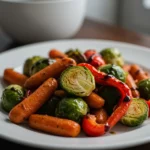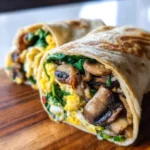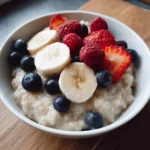If you’re searching for a dish that combines vibrant colors, tantalizing flavors, and nutritional benefits, look no further than Balsamic Glazed Roasted Vegetables. This delightful recipe features a mix of roasted Brussels sprouts, carrots, and bell peppers, all drizzled with a rich balsamic glaze. Perfect as a side dish or a main course, this recipe is sure to become a staple in your culinary repertoire.
Ingredients
Before diving into the preparation process, gather the necessary ingredients to ensure a seamless cooking experience. Here’s what you’ll need:
- Brussels sprouts: 2 cups, halved
- Carrots: 2 large, sliced into sticks
- Bell peppers: 2 (one red, one yellow), sliced
- Olive oil: 2 tablespoons
- Salt: 1 teaspoon
- Black pepper: 1/2 teaspoon
- Balsamic glaze: 1/4 cup
- Garlic: 2 cloves, minced
- Fresh thyme: 2 teaspoons, chopped
Instructions
Creating this delicious dish is straightforward. Follow these steps for perfectly roasted vegetables with a luscious balsamic glaze:
- Preheat the Oven: Set your oven to 425°F (220°C) to ensure it reaches the desired temperature while you prepare the vegetables.
- Prepare the Vegetables: Wash and dry the Brussels sprouts, carrots, and bell peppers. Halve the Brussels sprouts, slice the carrots into sticks, and cut the bell peppers into strips.
- Season the Vegetables: In a large bowl, combine the Brussels sprouts, carrots, and bell peppers. Drizzle with olive oil and season with salt, black pepper, and minced garlic. Toss until evenly coated.
- Arrange on a Baking Sheet: Spread the seasoned vegetables in a single layer on a large baking sheet. Ensure they are not overcrowded to allow even roasting.
- Roast the Vegetables: Place the baking sheet in the preheated oven and roast for 25-30 minutes. Stir halfway through to ensure even cooking and browning.
- Prepare the Balsamic Glaze: While the vegetables are roasting, prepare the balsamic glaze if you haven’t purchased a ready-made one. In a small saucepan over medium heat, reduce balsamic vinegar until it thickens and coats the back of a spoon.
- Drizzle with Balsamic Glaze: Once the vegetables are tender and caramelized, remove them from the oven. Drizzle with the balsamic glaze and sprinkle fresh thyme over the top.
- Serve Immediately: Transfer the balsamic glazed roasted vegetables to a serving dish and enjoy while warm.
Nutrition Facts
Understanding the nutritional content of your meals is essential for maintaining a balanced diet. Here’s a breakdown of the nutritional value per serving of these balsamic glazed roasted vegetables:
- Calories: Approximately 120
- Protein: 3g
- Carbohydrates: 18g
- Vitamin A: 150% of the Daily Value (DV)
- Vitamin C: 180% of the DV
- Calcium: 6% of the DV
- Iron: 8% of the DV
How to Serve
These balsamic glazed roasted vegetables are incredibly versatile, making them a fantastic addition to a wide variety of meals. Whether you’re looking for a side dish to complement a main course, a hearty vegetarian option, or a flavorful addition to salads and wraps, these roasted veggies can elevate any dish. Here are some detailed serving suggestions to inspire your culinary creativity:
As a Side Dish
Balsamic glazed roasted vegetables make an excellent side dish that can enhance the flavor profile of many main courses. Consider pairing them with:
- Roasted Chicken: The sweet and tangy notes of the balsamic glaze complement the savory flavors of roasted or grilled chicken, creating a well-rounded plate. For an extra touch, serve the chicken with a drizzle of balsamic reduction to tie the flavors together.
- Grilled Steak: The robust flavor of grilled steak is beautifully balanced by the caramelized sweetness of the roasted veggies. A side of garlic mashed potatoes can round out the meal, making it hearty and satisfying.
- Baked Fish: Light and flaky fish, such as salmon or tilapia, pairs wonderfully with these vegetables. The acidity of the balsamic glaze cuts through the richness of the fish, adding brightness to the dish. A squeeze of fresh lemon can further enhance this pairing.
Over Grains
Transform your balsamic glazed roasted vegetables into a filling and nutritious meal by serving them over various grains:
- Quinoa: This protein-packed grain offers a nutty flavor that complements the roasted vegetables perfectly. For added texture, mix in some fresh herbs like parsley or cilantro, and a squeeze of lemon juice before serving.
- Brown Rice: A staple in many households, brown rice provides a hearty base for the vegetables. Top with avocado slices and a sprinkle of sesame seeds for a delightful crunch and extra creaminess.
- Couscous: This quick-cooking grain can be dressed with olive oil, lemon, and a pinch of salt to enhance its flavor. The light and fluffy texture of couscous works beautifully with the roasted veggies, creating a delightful contrast.
In a Salad
Elevate your salad game by incorporating balsamic glazed roasted vegetables for added flavor and nutrition:
- Mixed Greens: Toss your favorite leafy greens, such as arugula, spinach, or romaine, with the roasted veggies. Add in some protein like grilled chicken or chickpeas for a satisfying meal. Drizzle with a light vinaigrette made from olive oil, balsamic vinegar, and a touch of honey to enhance the dish.
- Nuts and Seeds: For extra crunch and nutrition, consider adding toasted nuts or seeds, such as walnuts, pecans, or pumpkin seeds. They provide healthy fats and a delightful texture that contrasts with the softness of the roasted vegetables.
- Cheese: Feta cheese or goat cheese can add a creamy element to your salad, enhancing the overall flavor. The saltiness of the cheese pairs well with the sweet and tangy balsamic glaze.
In Wraps
Get creative with wraps by using balsamic glazed roasted vegetables as a flavorful filling:
- Vegetable Wraps: Spread a layer of hummus or avocado on a whole grain tortilla and layer on the roasted vegetables. Add fresh spinach or arugula for a burst of freshness, and roll it up for a quick and nutritious lunch option.
- Sandwiches: Incorporate the roasted veggies into sandwiches for a hearty vegetarian option. Pair them with feta cheese or mozzarella, and add a spread of pesto or aioli for an extra flavor kick. These can be served cold or grilled for a warm, melty treat.
- Pita Pockets: Stuff the roasted vegetables into whole wheat pita pockets along with a dollop of tzatziki or a yogurt-based dressing. This makes for a refreshing and satisfying meal that’s perfect for on-the-go dining.
Conclusion
The versatility of balsamic glazed roasted vegetables allows them to be served in numerous ways, making them a fantastic addition to any meal. Whether you choose to enjoy them as a side dish, atop grains, in salads, or as a filling for wraps, their delightful flavor and texture will surely impress. Get creative and experiment with different combinations to find your perfect pairing!
Additional Tips
To ensure your balsamic glazed roasted vegetables turn out perfectly every time, consider these additional tips:
1. Uniform Size Matters
One of the most critical factors in achieving perfectly roasted vegetables is ensuring they are cut into uniform sizes. This is crucial because different sizes will cook at different rates, leading to some vegetables being overcooked while others remain underdone. Aim for pieces that are roughly 1 to 2 inches in size; this allows for a good balance between tenderness and a slight crispness. For example, if you’re using carrots, sweet potatoes, or bell peppers, cut them into similar thicknesses to promote even cooking. If you’re working with denser vegetables, like potatoes or carrots, consider cutting them smaller than softer vegetables, like zucchini or bell peppers, to account for their longer cooking times.
2. Don’t Skimp on Heat
The high roasting temperature is crucial for caramelization and flavor development. Preheat your oven to at least 425°F (220°C) before adding your vegetables. This high heat helps to brown the sugars in the vegetables, creating that delicious caramelized exterior that enhances the overall flavor. Additionally, roasting at a higher temperature produces a delightful contrast between the crispy edges and the tender interiors of the vegetables. If you’re using a convection oven, you might even consider lowering the temperature slightly (around 400°F or 200°C) since convection cooking circulates hot air and can lead to faster cooking.
3. Experiment with Vegetables
Don’t hesitate to get creative with your vegetable selections! While traditional choices like bell peppers, onions, and Brussels sprouts are fantastic, you can enhance your dish by incorporating a variety of seasonal vegetables. Try adding sweet potatoes for a hint of natural sweetness, zucchini and yellow squash for a lighter touch, or asparagus for a vibrant green addition. Root vegetables like parsnips or beets can also offer a unique flavor profile and color contrast. Consider the textures and flavors of the vegetables you choose; denser vegetables may require a longer roasting time, while softer varieties will cook more quickly. Mixing textures can create a more interesting and satisfying dish.
4. Use Fresh Herbs
While dried herbs can certainly add flavor, using fresh herbs can elevate your dish to new heights. Fresh thyme or rosemary, for example, can impart a fragrant aroma and a burst of freshness that complements the rich balsamic glaze beautifully. Chop the herbs coarsely and toss them with the vegetables before roasting. If fresh herbs are not available, dried herbs can be used, but remember that they are more concentrated in flavor. As a general rule, use about one-third of the amount of dried herbs compared to fresh. Additionally, consider adding herbs at different stages – some can be mixed in before roasting, while others, like basil or parsley, can be sprinkled on after cooking for a fresh finish.
5. Make It a Meal
To transform your balsamic glazed roasted vegetables into a complete meal, consider adding protein-rich ingredients like chickpeas or tofu before roasting. Chickpeas, when tossed in with the vegetables, not only enhance the nutritional value but also provide a satisfying texture. For tofu, press and cube it, then marinate it briefly in balsamic vinegar, olive oil, and your choice of seasonings before adding it to the roasting pan. This additional step allows the tofu to absorb flavors and crisp up nicely during roasting. You can also explore other protein options like tempeh or even nuts and seeds for added crunch and nutrients. Serve your roasted vegetable medley over a bed of quinoa, rice, or a fresh salad to create a hearty, well-rounded dish.
By following these tips, you can ensure that your balsamic glazed roasted vegetables are not only delicious but also visually appealing and nutritionally balanced, making them a standout dish at any meal.
FAQs
1. Can I prepare the vegetables in advance?
Yes, you can chop the vegetables a day ahead and store them in the refrigerator. However, it’s best to roast them fresh for optimal flavor and texture.
2. What if I don’t have balsamic glaze?
You can make a simple balsamic reduction by simmering balsamic vinegar on low heat until it thickens. Alternatively, use a mixture of balsamic vinegar and honey as a substitute.
3. Are there gluten-free alternatives for this recipe?
All ingredients in this recipe are naturally gluten-free. Just ensure that any purchased balsamic glaze is certified gluten-free.
4. How do I store leftovers?
Store leftovers in an airtight container in the refrigerator for up to 3 days. Reheat in the oven or microwave before serving.
5. Can I freeze roasted vegetables?
While it’s possible to freeze roasted vegetables, they may lose some texture upon thawing. It’s best to enjoy them fresh.
Conclusion
Balsamic Glazed Roasted Vegetables represent not just a dish, but a celebration of flavors and nutrition that can elevate any meal. This culinary creation beautifully marries the robust, tangy sweetness of balsamic vinegar with the natural earthiness of a variety of vegetables. The result is a dish that is not only visually appealing—with its array of colors and textures—but also rich in taste and health benefits.
A Simple Yet Sophisticated Dish
At the heart of Balsamic Glazed Roasted Vegetables is simplicity. The preparation involves minimal ingredients and straightforward techniques, making it accessible even for novice cooks. Yet, the outcome is sophisticated enough to impress even the most discerning palates. Roasting the vegetables caramelizes their natural sugars, enhancing their flavor profiles, while the balsamic glaze adds a luxurious touch that elevates the entire dish. This combination allows you to transform everyday ingredients into a gourmet experience, making it an ideal choice for both casual family dinners and formal gatherings.
Versatile Serving Options
One of the standout features of this dish is its versatility. Balsamic Glazed Roasted Vegetables can serve multiple roles on your dining table. As a side dish, they complement a wide variety of proteins, such as grilled chicken, roasted meats, or hearty plant-based options like quinoa or lentils. Alternatively, they can shine as a main course when paired with a grain like farro or served atop a bed of mixed greens for a vibrant salad. For those who love to experiment, these roasted vegetables can also be blended into a warm grain bowl, incorporated into wraps, or used as a topping for pizzas and flatbreads. The possibilities are truly endless, making this dish a staple in any kitchen.
Rich Nutritional Benefits
Beyond their flavor and versatility, Balsamic Glazed Roasted Vegetables are packed with nutritional benefits. The choice of vegetables can be tailored to seasonal availability, allowing you to maximize freshness and nutrient density. Common choices include bell peppers, zucchini, carrots, and Brussels sprouts, each bringing unique vitamins, minerals, and antioxidants to the table. The roasting process not only intensifies their natural flavors but also makes certain nutrients more bioavailable. For instance, the heat can enhance the absorption of carotenoids from carrots and bell peppers. Furthermore, the balsamic vinegar itself is known for its potential health benefits, including aiding digestion and providing antioxidants.
An Invitation to Explore Culinary Creativity
This dish also serves as an invitation to explore your culinary creativity. While the basic recipe is wonderful as is, there is ample room for customization. Experimenting with different herbs and spices, such as rosemary, thyme, or garlic, can impart new dimensions of flavor. You might also consider adding a sprinkle of feta cheese, a drizzle of olive oil, or even a handful of nuts for added texture and richness. Seasonal adjustments—such as incorporating butternut squash in the fall or asparagus in the spring—can keep this dish exciting and fresh year-round.
A Call to Action
In conclusion, Balsamic Glazed Roasted Vegetables are more than just a recipe; they are an opportunity to embrace the vibrant flavors of fresh produce while enjoying the myriad health benefits they provide. This dish is not only easy to prepare but also adaptable to various dietary preferences and occasions. Whether you are looking to impress guests at a dinner party, seeking a nutritious addition to your weekly meal prep, or simply wanting to enjoy a delicious and wholesome dish, Balsamic Glazed Roasted Vegetables are a perfect choice. So, gather your favorite vegetables, grab a bottle of balsamic vinegar, and embark on a culinary adventure that promises both taste and nourishment. Embrace the wholesome goodness of this delightful dish today and savor every bite!
Print
Balsamic Glazed Roasted Vegetables
Ingredients
Before diving into the preparation process, gather the necessary ingredients to ensure a seamless cooking experience. Here’s what you’ll need:
- Brussels sprouts: 2 cups, halved
- Carrots: 2 large, sliced into sticks
- Bell peppers: 2 (one red, one yellow), sliced
- Olive oil: 2 tablespoons
- Salt: 1 teaspoon
- Black pepper: 1/2 teaspoon
- Balsamic glaze: 1/4 cup
- Garlic: 2 cloves, minced
- Fresh thyme: 2 teaspoons, chopped
Instructions
Creating this delicious dish is straightforward. Follow these steps for perfectly roasted vegetables with a luscious balsamic glaze:
- Preheat the Oven: Set your oven to 425°F (220°C) to ensure it reaches the desired temperature while you prepare the vegetables.
- Prepare the Vegetables: Wash and dry the Brussels sprouts, carrots, and bell peppers. Halve the Brussels sprouts, slice the carrots into sticks, and cut the bell peppers into strips.
- Season the Vegetables: In a large bowl, combine the Brussels sprouts, carrots, and bell peppers. Drizzle with olive oil and season with salt, black pepper, and minced garlic. Toss until evenly coated.
- Arrange on a Baking Sheet: Spread the seasoned vegetables in a single layer on a large baking sheet. Ensure they are not overcrowded to allow even roasting.
- Roast the Vegetables: Place the baking sheet in the preheated oven and roast for 25-30 minutes. Stir halfway through to ensure even cooking and browning.
- Prepare the Balsamic Glaze: While the vegetables are roasting, prepare the balsamic glaze if you haven’t purchased a ready-made one. In a small saucepan over medium heat, reduce balsamic vinegar until it thickens and coats the back of a spoon.
- Drizzle with Balsamic Glaze: Once the vegetables are tender and caramelized, remove them from the oven. Drizzle with the balsamic glaze and sprinkle fresh thyme over the top.
- Serve Immediately: Transfer the balsamic glazed roasted vegetables to a serving dish and enjoy while warm.
Nutrition
- Serving Size: one normal portion
- Calories: 120
- Carbohydrates: 18g
- Protein: 3g






